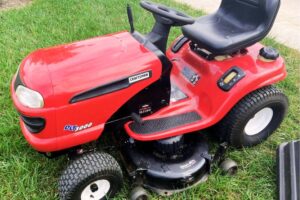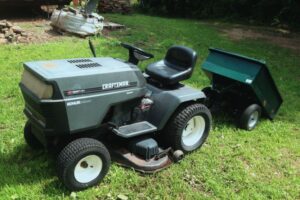With regular maintenance and proper use, you will be able to use your lawnmower for a long time. However, you have to be prepared for any eventualities because of normal wear and tear. If your lawnmower won’t start, you need to know the causes and how to fix them.
The most common and easiest lawnmower problem is a dirty, disconnected, or loose spark plug. You need to unscrew it, check its condition, clean off the dirt and soot, and then screw it back tight in its place. If it has some damage, replace it with a new one. Another common issue is a dirty air filter. Just clean it and reinstall it back.
If the fuel is not reaching the engine, the engine won’t start. Just tapping the side of the carburetor will help the gas flow to the engine. A dirty carburetor can also cause the engine to hesitate. You need to remove and clean the carburetor and reinstall it in its former position.
Read on to learn more about why your lawnmower won’t start, the possible causes, and how to make it start again.
Lawnmower Won’t Start
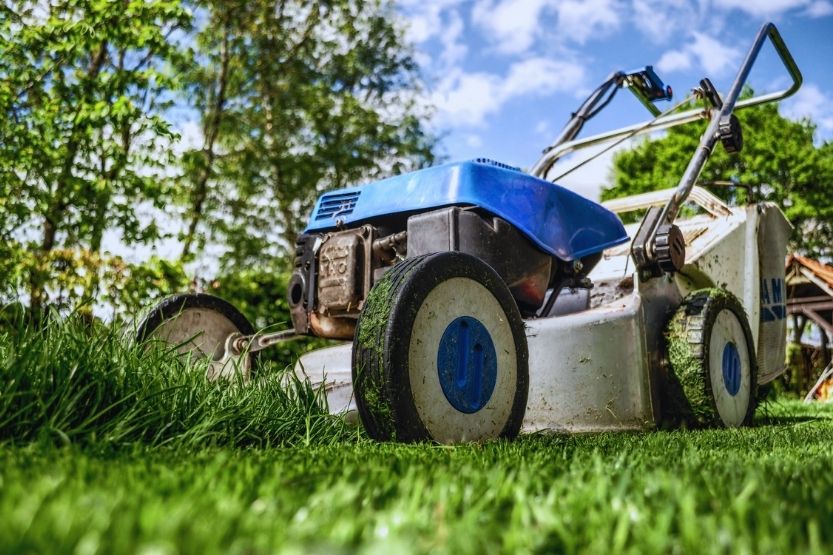
Bad Spark Plug
Even with proper use and regular maintenance, you will find that your lawn mower will not start at times. There are many reasons for this. The most common cause and easiest fix is a bad spark plug.
Perhaps it is not correctly seated in its place, or it is disconnected, or it is dirty. Unscrew the spark plug from its seat and inspect it. If its tip is filled with soot, clean it with a clean rag to remove the black deposits. Use fine-grade sandpaper to scrape off the soot in the spark gap.
When screwing back the spark plug in its place, see that it is correctly seated before finally tightening it. If you find that the spark plug has cracks or the spark gap is already too wide, replace it with a new one.
Dirty Filter
The other most common cause is a dirty filter. Just remove the filter from its place. Check for dirt and debris. Use a soft brush or cloth to remove the debris. Then put it back in its place. If it is already worn out, replace it with a new one.
Aside from these two most common causes, there are other reasons why your lawnmower won’t start. The rest of this article will provide you with enough details about these other causes why your lawnmower won’t start after running.
More on Possible Causes of Lawnmower Not Starting
If you want to extend your lawnmower’s life and prevent future problems, you need to practice careful handling and regular maintenance. However, even if you are religious in doing these things, there will be times when it won’t start even after vigorous cranking of the engine.
There must be a reason holding it back. You may be asking yourself: “Why won’t my lawnmower start?” There are many reasons why. Here, in detail, are the reasons why your lawn mower won’t start. Along with the problems, I’ll show you how to fix them:
1. Spark Plug Problems
When your riding lawnmower doesn’t start, the first thing you need to check is the engine’s spark plug. This is the easiest issue you can fix, so it’s the first one you need to check. The spark plug provides the spark required to ignite the fuel/air mixture inside the combustion chamber.
If it is disconnected, loosely connected, or filled with soot, it won’t be able to do its work. So, there are three things you need to check in the spark plug:
- Dirt and Oil: If the spark plug is full of oil and blackened with soot, it indicates a mechanical fault or too much oil is present in the engine.
- Dry: If the spark plug is too dry, it indicates a fault in the choke, or there is a block in the fuel system.
- Wet: When the spark plug is too wet, it indicates too much fuel going inside the engine. This could cause engine flooding, which will cause the engine to stall.
How to Fix Spark Plug
To fix spark plug problems, you need to do the following:
- Remove the spark plug from the engine by disconnecting the spark plug wire.
- Use an appropriate socket wrench and unscrew the spark plug from its socket.
- Check the electrode and insulator of the spark plug. Look for soot build up, cracks on the insulator and other damages. If there is any damage, replace the spark plug.
- If the spark plug is still ok, spray brake cleaner onto it and let it soak for a while and then wipe it with a clean cloth.
- Reinstall the spark plug by screwing it inside its socket first by your hand. When you feel that it is already properly seated, use the socket wrench to tighten it.
- If your lawnmower still won’t start, replace the old spark plug with a new one with the same specs.
3. No Fuel Inside the Combustion Chamber
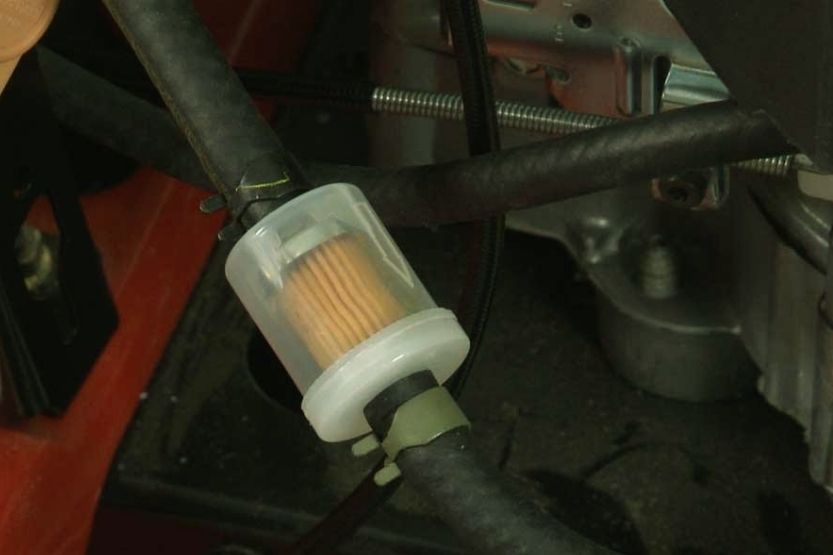
Another reason why your lawnmower won’t start is because perhaps, the fuel is not being delivered to the engine. The spark plug provides the spark, but no fuel will ignite inside the chamber, so it can’t run.
How to Fix When Fuel Is Not Delivered to the Engine
Tap the side of the carburetor. This will somehow disturb whatever is blocking the flow of fuel. Hopefully, this will fix the issue. If it does not, try replacing the fuel filter. Perhaps it can no longer filter out the small impurities that may have contaminated the fuel.
Again, a lawnmower won’t start – what are some of the causes for this issue? When your mower won’t start, the most common issues you should check include loose, dirty, or disconnected spark plug, dirty air filter, and fuel that doesn’t reach the engine.
4. Dirty or Bad Carburetor
A dirty carburetor can also cause your lawnmower not to start. The carburetor’s job is to see that the right fuel and air mixture is introduced inside the combustion chamber. If there is too much fuel in the mixture, soot will be produced, and the carburetor will get dirty with it.
How to Fix Bad Carburetor
You need to remove the carburetor from the engine assembly. This is quite a complicated task if you don’t know how to do it. So, it is better to ask a lawnmower mechanic to do it. However, if you can follow instructions from carburetor manuals, you can do it yourself and save some money. There are carburetor cleaners that you can use for this purpose.
A bad or malfunctioning carburetor is the probable cause if your lawnmower won’t start after winter. About 80% of lawnmowers can’t start after winter because of carburetor problems. So, be sure that you have cleaned the carburetor of your lawnmower before keeping it in storage before winter comes.
5. Choke System Problems
A faulty choke system could also cause small gasoline that doesn’t start. The choke ensures that the engine can run from a cold start. It modifies the fuel mixture by restricting the amount of air entering the carburetor during the engine startup.
If the engine is cold, you should set the choke switch at full choke. Ensure that the choke plate is working properly. If this plate does not close, the engine will not start.
How to Fix Choke System
If this is the case with your engine, you can fix the problem by adjusting the cable to move entirely to the closed position. In addition, you should also understand that if the choke sticks to the open position, the engine will produce black smoke. Your lawnmower will also run inefficiently.
6. Dirty or Clogged Filter
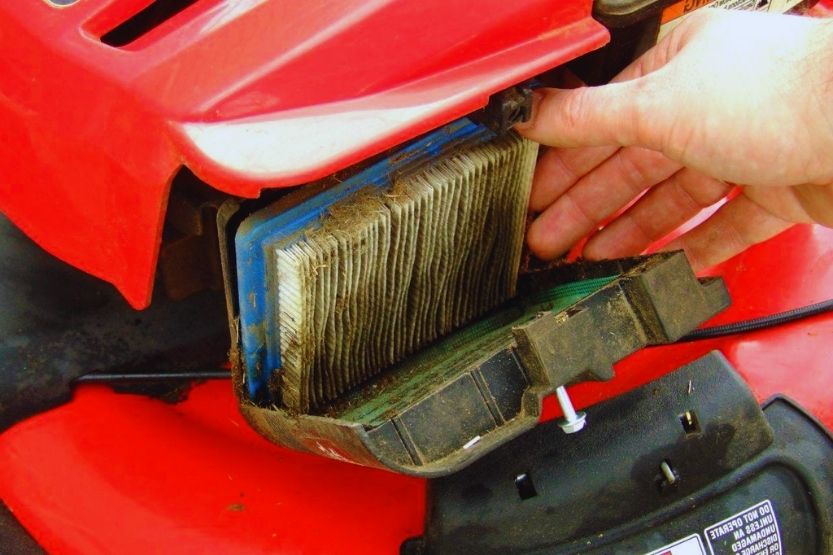
The air filter of your lawnmower filters out the contaminants from the air before it enters the carburetor. Debris such as fine dirt, grass clipping, and other contaminants can clog this filter. When it gets dirty and clogged, only a small amount of air can enter the carburetor.
This will prevent the engine from starting because the correct air/fuel mixture required to fire the engine is not being delivered. You can prevent this condition by replacing the air filters regularly. The recommendation is to change it after every 25 hours of continuous lawnmower use.
How to Fix Clogged Filter
You need to remove the filter so that you can clean it. But if it is already worn out and too dirty, you need to replace it with a new one. The process of removing the filter of a walk-behind lawnmower is different from a riding lawnmower.
With the walk-behind version, you need to remove the spark plug wire from the spark plug. Then, remove the filter from its housing. If you have a riding lawnmower, you need to turn the engine off and engage the parking brake.
If the filter is made of foam, you can wash it clean with detergent and warm water. This will break up the grime. But if the filter is made of paper, you need to replace it altogether.
7. Damaged Dead Man’s Cable
This cable is a lawnmower safety feature that prevents accidents. The lawnmower’s engine will stop when you release this cable or bar. It should always be in its proper place when the engine is running. So, this cable could be one reason why your riding lawnmower won’t start.
This cable is connected to the ignition coil of the engine. If this cable is broken or damaged, it won’t send the current to the spark plug, and the engine won’t start.
How to Fix Dead Man’s Cable
Check if this cable is damaged or broken. If it is, replace it with a new one. This is relatively easy to do. But if you are not confident about it, ask a lawnmower technician to do it for you.
Easy Fixes When Your Lawnmower Won’t Start
To summarize everything that I discussed before, here are some easy fixes you can perform if your lawnmower won’t start:
- Check or replace the spark plug
- Ensure that the right amount of fuel/air mixture is delivered to the engine
- Check or repair the choke
- Clean or replace the air filter
- Check and clean the carburetor
- Check or replace the dead man’s cable
Conclusion: Lawnmower Won’t Start
If you have been using and taking care of your lawnmower properly, several things will prevent it from starting when you crank its engine. The most common cause is a bad spark plug. It might just be disconnected, dirty, or loose.
Just check its condition, clean the soot, and then screw it back tightly. Perhaps it has gone bad already, and you need it replaced. Another common cause is a dirty filter. Just the same with the spark plug; it could be covered by soot or debris. Cleaning it will solve the problem. If it is already damaged, you have to replace it.
Related reading:
Craftsman YT3000 Spec and Reviews
Honda Harmony 215 Lawn Mower (HR215)


